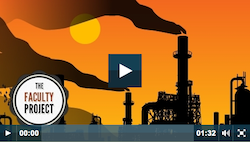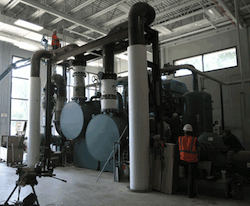When many of us think of solar energy the first thing that comes to mind is a solar panel. But there are other solar technologies that can generate renewable energy. Solar thermal hot water and space heating systems are gaining in popularity here in the U.S. and have already become widespread in countries such as China. A solar thermal system uses the sun to directly heat water and air that circulates in their processess, buildings, offices and homes.
“Business owners are sometimes concerned that solar thermal may not provide enough energy for their needs,” said Nigel Cotton, OEM Team Leader for the International Copper Association and founder of Solarthermalworld.org. “But there are many ways to combine solar thermal with other types of renewable energy that will allow it to provide more energy while continuing to refrain from adding carbon emissions to the environment.”
 One way to stretch the sun further is to combine solar thermal with geothermal pumps. Geothermal heat pumps bring heat up from under the ground to combine with the heat of the solar thermal system. In addition, the geothermal exchanger can serve as a storage tank for excess heat from the solar thermal system. These kinds of innovations in solar thermal systems can be used in settings where hot water is either essential or secondary to the operations of the organization or home.
One way to stretch the sun further is to combine solar thermal with geothermal pumps. Geothermal heat pumps bring heat up from under the ground to combine with the heat of the solar thermal system. In addition, the geothermal exchanger can serve as a storage tank for excess heat from the solar thermal system. These kinds of innovations in solar thermal systems can be used in settings where hot water is either essential or secondary to the operations of the organization or home.
The technology is already being tested successfully at Brown University located in Providence, Rhode Island. They are testing a hybrid system of solar thermal and PV to provide heat for the building and hot water for its swimming pool. Combining the two energy sources have helped each successful technology become even more powerful.
Cotton added, “Solar thermal is an extremely versatile technology. Combination systems are the next step in the application of solar thermal as a leading renewable energy technology.”






 In a conference call with reporters, API Downstream Group Director Bob Greco presented a “new analysis” of EPA’s regulations which claims “an estimated half of all gasoline station equipment is not compatible with E15” and said that this could result in serious safety and environmental problems for consumers.”
In a conference call with reporters, API Downstream Group Director Bob Greco presented a “new analysis” of EPA’s regulations which claims “an estimated half of all gasoline station equipment is not compatible with E15” and said that this could result in serious safety and environmental problems for consumers.”




